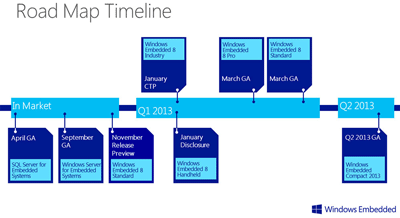News
Microsoft Releases Preview Version of Windows Embedded 8 Standard
- By Kurt Mackie
- November 16, 2012
Microsoft this week took the wraps off its roadmap and marketing vision for the upcoming Windows Embedded 8 product.
The new emerging embedded operating system product line is based on Windows 8, but Microsoft has separate product teams managing the code. And while Windows 8 for PCs was released last month, the new Windows Embedded 8 products aren't yet available except at the test phase.
Embedded Roadmap
The latest news is that Windows Embedded 8 Standard can now be downloaded as a "release preview," which is available here. It was last available as a version-2 community test preview release. Windows Embedded 8 Standard is scheduled for general availability in March.
Microsoft also is building four other Windows Embedded 8 editions, which aren't described in very much detail in Microsoft's announcement. One of those products is Windows Embedded 8 Pro, which will be generally available in March 2013. A second one is Windows Embedded 8 Industry, which is set for a community technology preview release in January 2013. Windows Embedded 8 Industry apparently is the successor to Windows Embedded POSReady 7 OS, which is designed for point-of-sale devices. A third product is Windows Embedded 8 Handheld for handheld devices, which Microsoft plans to talk about more in January. Lastly, Microsoft plans to disclose more information about Windows Embedded 8 Automotive in "early 2013."
The compact line is continuing, too, but Microsoft is calling the next version "Windows Embedded Compact 2013." It's designed for small-footprint devices and will support touch and gesture user interfaces. Windows Embedded Compact 2013 will hit general availability sometime in the second quarter of 2013. Microsoft is building its Windows Embedded Compact 2013 OS for both the x86 and ARM hardware platforms, according to Microsoft's roadmap announcement made last year.
A Microsoft spokesperson clarified that Windows Embedded Compact 2013 will be based on the Windows CE kernel.
"The Windows Embedded 8 family of products, including Windows Embedded 8 Standard, Windows Embedded 8 Pro, Windows Embedded 8 Industry and Windows Embedded 8 Automotive, will share the Windows codebase," the spokesperson related via e-mail. "Beyond that, Windows Embedded Compact 2013 will remain on the Windows CE kernel, and Windows Embedded Handheld 8 will move to the Windows Phone codebase."
Two embedded server products have already been released. SQL Server for Embedded Systems was released in April. Windows Server 2012 for Embedded Systems was released in September.
The revised Windows Embedded 8 roadmap can be seen in the Microsoft-produced graphic below. In general, Microsoft is promising to deliver touch and gesture capabilities with the new Windows 8-based and compact embedded OSes, when released. The new embedded OSes also will have broad development support in Visual Studio 2012.

|
| Windows Embedded Roadmap. Source: Microsoft. |
Embedded Vision
Windows Embedded is that other Windows product line associated with industrial devices, kiosks and electronic signs that are the traditional focus, along with Linux, of original equipment manufacturers and independent software vendors. The embedded side of Windows has always been a big healthy part of Microsoft's mobile operating system market. On the other hand, the consumer-oriented Windows Mobile side has tended to flounder.
Last year, the Windows Embedded team announced a restructuring to become more agile in developing Windows Embedded for business scenarios, with releases expected to happen more frequently. The company combined its "development teams for each of the Windows Embedded solutions -- Windows Embedded Standard, Windows Embedded Enterprise, Windows Embedded Compact 7 -- into one larger team focused on creating many products with a common platform," according to that announcement.
Over the last year or so, Microsoft has been articulating an "intelligent systems" vision for its Windows Embedded OSes. This intelligent systems idea follows from the notion that the world is becoming more and more device centric, in which interconnections will happen through the Internet cloud. Microsoft has already made efforts to address the mobile device shift with Windows 8, which runs both on PCs and tablets and is optimized for touch. Now it's expecting businesses to want to use connected device data for a number of new applications. One of those proposed new applications is a more "intelligent" hotel check-in kiosk and management console, as described in this blog.
Should this sort of vision take off, it may represent a growing OS market for Microsoft, even as traditional PC OS sales flatten. According to a Microsoft-sponsored IDC white paper (PDF) published in April, greater growth will occur in the embedded OS market compared with the PC, tablet, or smartphone OS markets.
"IDC estimates that the intelligent systems market will grow from 19% of all major electronic system unit shipments in 2010, to more than 27% of all systems by 2016," IDC's white paper predicts.
Microsoft is also describing device management through System Center as an important part of this intelligent systems vision, as well as the use of Windows Azure. Or, at least the marketing has been consistent along those lines. Microsoft announced its "all-in" move to the cloud back in March 2010. Recently, Microsoft announced that it had become a "devices and services" company in a letter from CEO Steve Ballmer to Microsoft's shareholders.
Other components important to the new Windows Embedded vision, according to Kevin Dallas, Microsoft's general manager of Windows Embedded, include Forefront security, identity, Kinect touch and motion, and analytics through the use of SQL Server and PowerView.
About the Author
Kurt Mackie is senior news producer for 1105 Media's Converge360 group.